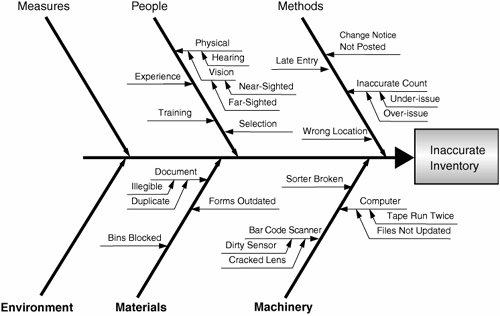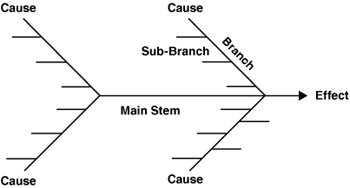Section 21. Fishbone Diagram
21. Fishbone DiagramOverviewThe ubiquitous Fishbone Diagram (also known as a Cause & Effect Diagram) is a well-known quality tool but was dropped from the Six Sigma Process Improvement Roadmap a number of years ago, replaced completely by the Process Variables Map and Cause & Effect Matrix combination. It does however have a place in a few Lean Sigma problem categories that aren't related to a single process. The Fishbone Diagram (obviously named for its looks) is a Team brainstorming tool to help identify potential root causes to problems, or in Lean Sigma terms Key Process Input Variables (KPIVs) or Xs. The problem is tackled by examining six major process related areas (Branches):
These are then broken down further into Sub-Branches, effectively following the 5 Whys principal until some potential root causes (Xs) are identified. Therefore, the tool is another means to generate process Xs. Figure 7.21.1. Structure of a Fishbone Diagram. An example Fishbone Diagram is shown in Figure 7.21.2. Figure 7.21.2. Example Fishbone Diagram relating to warehouse inventory variances. LogisticsThe Fishbone Diagram is absolutely a Team endeavor. It typically takes about one to two hours to complete in a brainstorming session with Team members and other key process experts. It is best done in one sitting, so if it can't be completed during the time available postpone until a more suitable time. Belts are strongly advised not to create a straw man of the Diagram prior to the meeting; this approach usually causes a lack of buy-in to the result and also potential missed Xs. RoadmapThe Roadmap is relatively straightforward:
Table 7.21.1 can help break down the groups and also identify those trickier Xs.
Interpreting the OutputThe biggest mistake Belts make is reverting to the traditional use of the Fishbone Diagram; Process Improvement Teams would look at all the Xs generated and from gut-feel decide which Xs to pursue. This is incorrect in Lean Sigma and in fact, could completely derail the project. The Fishbone Diagram is used only to identify the potential Xs, not to prioritize them. Subsequently, more suitable tools (the Cause & Effect Matrix, Failure Mode and Effects Analysis, and Multi-Vari Study) narrow them down to the critical few. There should be absolutely no action items coming from the Fishbone Diagram other than to transfer the Xs to the next tool. |
EAN: 2147483647
Pages: 138
